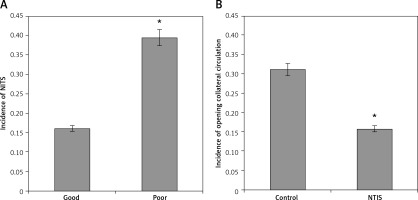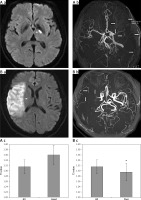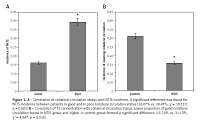Introduction
Non-thyroidal illness syndrome (NTIS), part of the neuroendocrine response to stress, is a state of adaptation or dysregulation of thyrotropic feedback control where the levels of triiodothyronine (T3) and free triiodothyronine (fT3) are at unusual levels, but the level of thyroid-stimulating hormone (TSH) is normal. Apart from severe illness and surgery, NTIS is also common in old patients with risk factors for cardiovascular disease [1–3]. NTIS is one of the signs for poor prognosis in patients with cerebral infarction (CI) [4–6], but its related influencing factors had never been explored. In a previous study, we found that large artery atherosclerosis cerebral infarction (LAA-CI) patients with NTIS had more severe neurological deficits [7]. In this study, we mainly investigated the potential effect of collateral circulation on prognosis prediction of triiodothyronine in LAA-CI patients, which would provide a guideline for the treatment and prognosis prediction of CI.
Material and methods
Study subjects
Thyroid function test information of CI patients admitted to our hospital between 2010 and 2012 was collected. A total of 208 patients (132 male and 76 female) aged 48–94 year old were divided into a control group (n = 151) and an NTIS group (n = 57). The diagnosis criteria for CI referred to “Guidelines for the early management of patients with acute ischemic stroke: a guideline for healthcare professionals from the American Heart Association/American Stroke Association” [8]. Excluded were patients with history of chronic thyroid diseases, history of taking drugs harmful to thyroxine, non-acute phase of CI, brain tumor, encephalitis, brain injury and severe multi-organ dysfunction. This study was approved by the Ethics Committee of Suzhou Hospital Affiliated to Nanjing Medical University.
Examination on admission and evaluation
Known history of smoking, hypertension, diabetes mellitus and coronary heart disease were collected when patients were admitted to hospital. NIHSS score was evaluated according to patients’ symptoms and signs. Fasting venous blood samples were collected within 24 h after admission for the measurement of biochemical index. Radioimmunoassay was performed to measure the levels of triiodothyronine (T3), total thyroid hormone (T4), thyroid-stimulating hormone (TSH), free triiodothyronine (fT3) and free thyroid hormone (fT4), with T3 < 1.21 nmol/l or fT3 < 2.63 pmol/l as the diagnostic criteria of NTIS [4]. Magnetic resonance imaging (MRI), magnetic resonance angiography (MRA), computed tomography angiography (CTA) and digital subtraction angiography (DSA) were used for determining TOAST classification, selecting patients with LAA-CI and evaluating collateral circulation. Imaging examination with prominent laterality of adjacent vessel on 3D TOF MRA or with hyperintense vessel on FLAIR MR was identified as opening of collateral circulation [9]. One-year follow-up was conducted in 170 patients (38 patients lost to follow-up) for mRS scores. Parts of characteristic indexes were stratified based on previous studies [10–12]. Prognosis with modified Rankin score (mRS): 0–2, good; 3–6, poor; 6 meaning death [7].
Statistical analysis
Continuous data in normal distribution were expressed as mean ± standard deviation and analyzed by t test. Continuous data in non-normal distribution were expressed as median and compared using the Mann-Whitney U test. Univariate analysis of categorical data (expressed with percentage) was performed using the χ2 test. Logistic regression was used to analyze the influencing factor for NTIS, with p < 0.05 indicating a significant difference.
Results
Univariate analysis on baseline data of the two groups showed that age, the ratio of patients with diabetes, systolic pressure and NIHSS scores at admission were higher in the NTIS group than in the control group (p < 0.05). The ratio of patients with collateral circulation opening was lower in the NTIS group than in the control group (p < 0.05). Prognosis analysis showed that patients in the NTIS group had poorer prognosis (p = 0.008) and the main cause was the higher mortality (p = 0.002) (Table I).
Table I
Demographic data and prognosis for patients with or without NTIS
As compared with the thyroid hormone level, T3 level in the NTIS group was lower than that in the control group (p = 0.001) while TSH level was higher than that in the control group (p < 0.001) (Table II).
Table II
Comparison of thyroid hormones between NTIS group and control group
Patients with collateral circulation opening had lower incidence of NTIS (p = 0.001, Figure 1 A) and patients with NTIS had a lower rate of collateral circulation opening (p = 0.026, Figure 1 B). Magnetic resonance imaging showed that patients with good collateral circulation had a smaller infarction lesion (Figures 2 A a and b) than patients with poor collateral circulation (Figures 2 B a and b). Compared with all patients, T3 level was not markedly increased in patients with good collateral circulation (1.36 ±0.28 vs. 1.32 ±0.38, n = 56, 208, p = 0.231, Figure 2 A c) while it was significantly lower in patients with poor collateral circulation (1.29 ±0.41 vs. 1.32 ±0.38, n = 152, 208, p = 0.014, Figure 2 B c).
Figure 1
A – Correlation of collateral circulation status with NTIS incidence. A significant difference was found for NTIS incidence between patients in good and in poor collateral circulation status (16.07% vs. 39.47%, c2 = 10.110, p = 0.001) B – Correlation of T3 concentration with collateral circulation status. Lower proportion of good collateral circulation found in NTIS group and higher in control group formed a significant difference (15.79% vs. 31.13%, c2 = 4.947, p = 0.026)

Figure 2
A – Lacunar infarction resulted from left middle cerebral artery occlusion with normal T3 value (1.53 nmol/ l) and good collateral circulation in a male patient 65 years old (A a and b). No significant difference was found for T3 value between good collateral circulation group and all patients (1.36 ±0.28 vs. 1.32 ±0.38, n = 56,208 respectively, p = 0.231, A c). Triangle stands for infarction lesions, solid arrows stand for opening collateral circulation and hollow arrows stand for arterial stenosis or occlusion. B – Large infarction resulted from right middle cerebral artery occlusion with low T3 value (0.98 nmol/l) and poor collateral circulation in a female patient 63 years old (B a and b). A significant difference was found for T3 value between poor collateral group and in all patients (1.29 ±0.41 vs. 1.32 ±0.38, n = 152,208 respectively, p = 0.014, B c). Triangle stands for infarction lesions, solid arrows stand for opening collateral circulation and hollow arrows stand for arterial stenosis or occlusion

Logistic regression showed that T3 levels (OR = 4.760, 95% CI: 1.981–11.456, p < 0.001) were positively but age (OR = 0.756, 95% CI: 0.645–0.886, p = 0.001) inversely correlated with the opening of collateral circulation (Table III).
Discussion
NTIS is one of the signs of poor prognosis in patients with CI [4–6]. Previous studies reported that NTIS was an independent predictor of survival in early and advanced stages in patients with acute infarction and could predict the degree of disability after 1 year [4, 5]. Compared with patients with the upper tertile of fT3 level, CI patients with lower tertiles of fT3 level had higher NIHSS scores, more severe neurological deficits, higher 1-year mortality, increased white blood cell count and higher frequency of ventricular compression [5]. The decreased T3 level also predicted more severe neurological deficits in CI patients when discharged from hospital [13]. Administration of TSH within 24 h after CI occurs can reduce the incidence of NTIS and decrease NIHSS scores [14]. T3 can reduce cerebral edema through inhibiting the expression of AQP4 [15]. T3 packaged with nanoparticles reduces the volume of CI and cerebral edema and is beneficial for drug performance on neuroprotection [16]. Basic research also found that supplementation of T3 activates the PI3/Akt kinase pathway and eNOS, which reduces the volume of CI in mice with transient focal CI and improves neurological deficits [17]. Those studies revealed that the increase of T3 level could improve the prognosis of CI.
Our previous study found that NTIS could better predict the neurological deficits in patients with LAA-CI [4]. A recent imaging study showed that the progression of infarction caused by LAA-CI, especially middle cerebral artery occlusion, is highly heterogeneous [18, 19]. In some cases, infarction could cause necrosis of the entire brain tissue in the ischemic region within 1 h, while other cases showed evidence of survival of tissues several days after CI. In patients with proximal arterial occlusion and survival of distal brain tissue, retrograde filling of the pial artery is a marker of collateral circulation opening in angiography. Imaging showed that blood flow through collateral circulation could perfuse brain tissues for several hours after artery occlusion. Hence, maintaining and increasing the blood flow through collateral circulation is a promising way to treat CI [19]. The opening of collateral circulation caused by activation of the PI3/Akt kinase pathway and the increased production of nitrogen oxide might be an important mechanism for the treatment with T3 supplementation in CI [17]. A previous study reported that lowering the T3 level could affect opening of collateral circulation through changing the distribution and deformability of erythrocytes [20], disturbing the expression of coagulation factors and genes [21–23], injuring vascular endothelial cells, smooth muscle, cardiac systolic and brain function [24–31].
Cheng-Ching et al. found that, in LAA-CI patients, the opening of collateral circulation shown in CTA could better predict the volume of the anterior circulation infarction core area shown in MR-DWI imaging which contributed to identifying the ischemic penumbra urgently needed to be saved [32, 33]. Fassbender revealed that the volume of CI was related to the stress degree of the hypothalamic pituitary axis [34]. Our prior study [7] also found that NTIS could better predict the degree of neurological deficits related to the volume of LAA-CI in the internal carotid artery system, so that the occurrence of NTIS might have a close association with the opening of collateral circulation. Previous studies have never reported the effects of collateral circulation on the prognosis in CI patients with NTIS and the association between T3 level and collateral circulation. This study found that patients with opening of collateral circulation had lower incidence of NTIS and a small infarction volume, and patients with NTIS had lower probability of opening collateral circulation and large infarction volume. After adjusting for other confounders such as age, sex and other risk factors for vascular disease, T3 levels were independently associated with opening status of collateral circulation. Recently, Menon et al. [35] reported that collateral circulation assessed by CTA was an independent prognostic predictor for CI both with endovascular treatment and with intravenous thrombolysis, which provided evidence consistent with this study that T3 level and prognosis of CI might be linked by opening of collateral circulation.
Age is another influencing factor for collateral circulation in patients with LAA-CI. Among several established risk factors for poor prognosis of ischemic stroke, collateral circulation has risen to the most prominent point with the development of vascular imaging, which proved to be affected by age, especially in patients with a proximal middle cerebral artery [32, 35–37]. On the other hand, with increasing age the production of TSH was decreased and the threshold of TSH levels to stimulate secretion of thyroid hormone was elevated. The reduction of TSH suggested the decline of hypothalamic-pituitary-thyroid (HPT) axis function [38]. Our study found that age and TSH levels in the NTIS group were significantly higher than those in the control group, while T3 levels were lower than in the control group, which indicated that elevated TSH stimulated by lower T3 levels could not promote the release of thyroid hormones, and further confirmed that the function and feedback decline of HPT failed to accommodate the change of the environment. In consequence replacement therapy was recommended for preservation of target organ function [39, 40]. The results suggested that collateral status and HPT function would keep the synchronous alteration trend and mutual confirmatory interaction varying with age when exposed to stroke stress.
Univariate analysis showed that systolic pressure and NIHSS scores at admission were higher in the NTIS group than in the control group [4]. However, multivariate analyses failed to find their associations with NTIS. Glycosylated hemoglobin A1c (HbA1c) level can reflect the levels of blood glucose before and after the onset [41], but this study did not find an association between HbA1c level and NTIS. The reason may be that NIHSS score and HbA1c level could not reflect infarction volume and stress degree consistently. Systolic pressure might be affected by the change of intracranial pressure, which resulted in the unmatched degree of stress reflected by T3 level.
There are some limitations of this study. Firstly, the resolution of collateral circulation evaluated by MRA is limited. Secondly, the relatively small sample size and patients lost to follow-up may lead to bias in the final results. Thirdly, the mismatch in age and gender could result in deviation of research findings. Fourthly, whether the disturbed thyroid hormones occurred pre- or post-stroke was not determined. Thus, a large sample prospective study based on high resolution angiography and more matched data are needed to verify the results.
In conclusion, this study firstly found that T3 level was closely associated with the opening of collateral circulation. Patients with collateral circulation opening had lower incidence of NTIS and patients with NTIS had a lower rate of collateral circulation opening. Prognosis analysis showed that patients in the NTIS group had poorer prognosis and the main cause was the high mortality. Clinical physicians can predict the condition of collateral circulation opening and prognosis according to the T3 level in the acute stage in elderly CI patients. Actions to maintain or promote the opening of collateral circulation with thyroid hormones may be considered for the improvement of prognosis in those patients.



